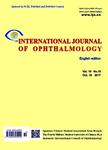6-weekly bevacizumab versus 4-weekly ranibizumab for neovascular age-related macular degeneration:a 2-year outcome
6-weekly bevacizumab versus 4-weekly ranibizumab for neovascular age-related macular degeneration: a 2-year outcome作者机构:St.Paurs Eye UnitRoyal Liverpool University HospitalLiverpool L7 8XPUK Eye Care CentreLeighton HospitalCrewe CW1 4Q JUK Eye DepartmentLeicester Royal InfirmaryLeicester LE15WWUK
出 版 物:《International Journal of Ophthalmology(English edition)》 (国际眼科杂志(英文版))
年 卷 期:2016年第9卷第4期
页 面:551-555页
核心收录:
学科分类:1002[医学-临床医学] 100212[医学-眼科学] 10[医学]
主 题:bevacizumab ranibizumab neovascular age related macular degeneration treatment on as required basis
摘 要:AIM: To compare visual acuity and central macular thickness(CMT) changes in neovascular age-related macular degeneration patients treated with either 6weekly bevacizumab regimen or 4 weekly ranibizumab on an as required basis.·METHODS: Patients made an informed choice between bevacizumab 1.25 mg or ranibizumab 0.5 mg. The selected treatment was administered in the first 3 *** patients were followed-up 6 weekly and ranibizumab 4 weekly. Retreatment criteria was based on the reduction of 〉5 letters in the best-corrected visual acuity(BCVA), the presence of retinal fluid on optical coherence tomography(OCT) or new retinal haemorrhage.·RESULTS: Visual acuity at 2y bevacizumab patients gained 7. 0 letters and ranibizumab 9. 2( P = 0. 31, 95 %CI-6.4 to 2.0). At 2y 86% of bevacizumab and 94%ranibizumab patients had not lost 15 letters or more(P =0.13). Mean CMT decreased at 2y bevacizumab by 146 μm,ranibizumab 160 μm(P =0.72). Mean number of injections was at 2y bevacizumzb 11.9, ranibizumab 10.3(P =0.023).· CONCLUSION: Bevacizumab 6 weekly on an as required basis was not demonstrably non-inferior to ranibizumab 4 weekly pro re nata(prn) in terms of BCVA and change in CMT. In the bevacizumab group, one more injection was required in the second year compared to the ranibizumab group.



